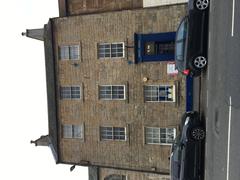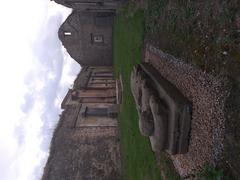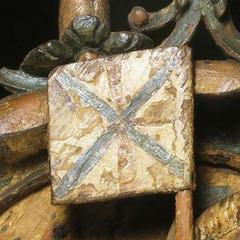Cairnpapple Hill: Visiting Hours, Tickets, and Historical Sites Guide in Livingston, United Kingdom
Date: 04/07/2025
Introduction
Cairnpapple Hill stands atop the picturesque Bathgate Hills in West Lothian, Scotland, as one of the nation’s most remarkable prehistoric monuments. This ancient ceremonial site, dating back to around 3500 BCE, offers a compelling journey through more than 5,500 years of ritual, burial, and cultural history. With its panoramic summit views and archaeological significance, Cairnpapple Hill provides invaluable insights into Neolithic, Bronze Age, and early Christian societies in Scotland.
Managed by Historic Environment Scotland, Cairnpapple Hill welcomes visitors seasonally, offering both self-guided exploration and occasional tours. The site features a visitor centre housed in a historic Nissen hut, interpretive displays, and access to reconstructed burial chambers. Its proximity to other West Lothian attractions, such as Linlithgow Palace and Beecraigs Country Park, makes Cairnpapple Hill an essential destination for history enthusiasts and families alike.
This comprehensive guide details Cairnpapple Hill’s history, opening hours, ticketing, accessibility, travel tips, and nearby attractions, ensuring you have all the practical and historical information needed for a rewarding visit.
Table of Contents
- Prehistoric Origins and Early Ritual Use
- Development into a Henge and Ceremonial Complex
- Bronze Age Transformation: Cairn Construction and Burial Practices
- Later Use: Early Christian Burials and Medieval Significance
- Rediscovery and Archaeological Investigation
- Etymology and Cultural Legacy
- Visiting Hours, Tickets, and Accessibility
- Travel Tips and Getting There
- Facilities and Visitor Centre
- Exploring Cairnpapple Hill: Features and Trails
- Nearby Attractions
- Frequently Asked Questions (FAQ)
- Summary and Visitor Tips
- References and Official Links
Prehistoric Origins and Early Ritual Use
Cairnpapple Hill is one of Scotland’s most significant prehistoric ritual and burial sites, with evidence of use beginning in the late Neolithic period, around 3500 BCE—predating the pyramids of Egypt (Historic Environment Scotland). Early activities included the creation of ceremonial pits and the placement of megalithic stones, likely for communal gatherings, ancestor worship, or astronomical observation. Artefacts such as pottery bowls and stone axe heads sourced from as far as Cumbria and North Wales highlight Cairnpapple’s importance within ancient trade and cultural networks (Bathgate Hills; Ancient Scotland; Wikipedia).
Development into a Henge and Ceremonial Complex
Over time, Cairnpapple Hill evolved into a sophisticated henge monument. A circular ditch and bank, with concentric rings of pits and postholes, surrounded the summit—typical of Neolithic ritual landscapes in Britain and Ireland. This phase is marked by repeated episodes of construction and use, suggesting that the site was a major centre for regional rituals and ceremonies, possibly aligned with celestial events (Bathgate Hills).
Bronze Age Transformation: Cairn Construction and Burial Practices
During the early Bronze Age (c. 2000–1500 BCE), Cairnpapple Hill was transformed from a ceremonial ground into a major burial monument. A large stone cairn, initially 15 meters in diameter and later expanded to 30 meters, was built over the henge, incorporating stone cists (burial chambers) and grave goods like food vessels. Additional cremation burials in urns were found within the expanded cairn, marking the site as a prominent Bronze Age tomb (Wikipedia; The Brain Chamber). The cairn’s construction and the inclusion of grave goods reflect complex social hierarchies and evolving beliefs about death and ancestry.
Later Use: Early Christian Burials and Medieval Significance
Cairnpapple Hill’s sacred status endured into the early medieval period. Several graves aligned east-west within the ditch are now identified as early Christian burials, dating from 500 to 1000 CE (Wikipedia; The Brain Chamber). These burials, along with historical references to the site as a “central sanctuary,” indicate continued reverence and spiritual significance throughout the ages (Bathgate Hills). Local legends also associate Cairnpapple with Druidic wisdom, though such stories remain speculative.
Rediscovery and Archaeological Investigation
By the 19th century, Cairnpapple Hill was obscured by forestry and largely forgotten. Its archaeological significance was revealed through excavations in 1947–1948 led by Stuart Piggott, which uncovered the site’s multi-phase history and complex sequence of monuments (Wikipedia; The Brain Chamber). Later research by Gordon Barclay in 1998 confirmed its status as a scheduled ancient monument. Today, visitors can explore a reconstructed cairn protected by a concrete dome, with color-coded gravel marking ancient features (Historic Environment Scotland).
Etymology and Cultural Legacy
The name “Cairnpapple” is linguistically intriguing, possibly meaning “Cairn of the tent,” “Cairn of the people,” or “Cairn of the eye,” with roots in Brythonic or Goidelic languages (Wikipedia; The Brain Chamber). Local myths abound, and the site’s alignment with solstice sunrises suggests an astronomical function. Cairnpapple Hill remains a place of fascination for skywatchers, folklore enthusiasts, and those interested in Scotland’s ancient spirituality (Bathgate Hills; The Modern Antiquarian).
Visiting Hours, Tickets, and Accessibility
- Opening Season: 1 April – 30 September; closed October – March.
- Daily Hours: 9:30 am – 5:30 pm (last entry 5:00 pm). Site may close briefly for lunch (WhichMuseum).
- Tickets: Standard entry fees apply, with concessions for children, seniors, and students. Carers accompanying disabled visitors are admitted free (up to two per transaction), no proof of disability required (Historic Environment Scotland).
- How to Buy: Purchase tickets online for convenience or on-site (subject to availability).
- Accessibility: The site includes uneven paths, multiple steps, and steep gradients. The visitor centre is accessed by two steep steps; the cairn interior requires descending a metal ladder. Wheelchair access is limited, but staff are available to assist as needed (Historic Environment Scotland).
- Facilities: No toilets onsite; nearest accessible toilets are 3.5 miles away at Beecraigs Country Park.
Travel Tips and Getting There
- By Car: Cairnpapple Hill is about 2 km east of Torphichen, near Bathgate and Linlithgow. Access via the M8 motorway, following signs to Beecraigs Country Park. Parking is available in a surfaced lay-by near the entrance, with a 500-meter uphill walk to the site (Rampant Scotland; Visit West Lothian).
- By Public Transport: Limited; nearest services are in Bathgate. Visitors may require a taxi or a 45-minute walk from town (My Voyage Scotland).
- Weather: The summit is exposed and can be windy or cold, even in summer. Dress in layers and bring waterproofs (Go Far Grow Close).
- Footwear: Sturdy, waterproof shoes are recommended due to uneven, occasionally muddy terrain.
Facilities and Visitor Centre
Housed in a historic Nissen hut, the visitor centre offers:
- Informative displays and exhibitions on Cairnpapple’s history and archaeology.
- A short film introducing the site and the surrounding landscape.
- Knowledgeable staff to answer questions and provide guidance (Scotland Road Trip).
There is no café or shop on-site, so visitors should bring their own refreshments. The grounds are suitable for picnics, but shelter is limited.
Exploring Cairnpapple Hill: Features and Trails
- Reconstructed Cairn: Visitors can enter a concrete dome replicating the second cairn uncovered in excavations, viewing reconstructed graves and burial chambers (WhichMuseum).
- Archaeological Markings: Colour-coded gravel indicates the locations of post holes, graves, and other features.
- Walking Trails: Several trails of varying length and difficulty encircle the summit, offering panoramic views of central Scotland. On clear days, you can see as far as Goatfell on Arran and the Firth of Forth (The Modern Antiquarian).
- Interpretive Panels: Guide visitors through the multi-layered history and significance of the site.
Nearby Attractions
Extend your visit with these West Lothian sites:
Frequently Asked Questions (FAQ)
Q: What are the visiting hours of Cairnpapple Hill?
A: Open daily 9:30 am–5:30 pm, 1 April–30 September. Closed October–March.
Q: How much are tickets?
A: Standard fees apply, with concessions and free entry for carers. Check Historic Environment Scotland for current rates.
Q: Is the site wheelchair accessible?
A: The visitor centre is accessible, but the archaeological site itself is not fully accessible due to steps and uneven ground.
Q: Are dogs allowed?
A: Yes, dogs (including assistance dogs) are welcome but must be kept on leads.
Q: Are there guided tours?
A: Occasional tours and special events are offered during the open season—check the official website for details.
Q: Where can I park?
A: Parking is available in a lay-by near the entrance, with a 500-meter walk to the site.
Summary and Visitor Tips
Cairnpapple Hill is a captivating destination, blending Scotland’s deep prehistoric roots with stunning natural vistas and accessible visitor experiences. Its multi-layered history, from Neolithic rituals to Bronze Age burials and early Christian graves, illustrates its enduring spiritual and cultural importance. Modern archaeological research and visitor facilities enhance your understanding and appreciation of this ancient landscape.
Visitor Tips:
- Plan your visit during the open season (April–September).
- Book tickets online for convenience.
- Wear sturdy shoes and dress for changing weather.
- Bring water and snacks; no refreshments are available on-site.
- Allow 1–2 hours for your visit, and consider exploring nearby attractions.
For immersive audio guides, offline maps, and up-to-date travel tips, download the Audiala app. Stay connected through social media for the latest news and events related to Scotland’s historic sites.
References and Official Links
- Historic Environment Scotland: Cairnpapple Hill
- Bathgate Hills: Cairnpapple Henge
- Ancient Scotland: Cairnpapple Hill
- Wikipedia: Cairnpapple Hill
- The Brain Chamber: Cairnpapple Hill
- SOBT: Cairnpapple Hill
- Rampant Scotland: Visit Cairnpapple Hill
- Scotland Road Trip: Visit Cairnpapple Hill
- WhichMuseum: Cairnpapple Hill
- Undiscovered Scotland: Cairnpapple Hill
- UK Travel Planning: Best Time to Visit UK
- Go Far Grow Close: Best Places to Visit in the UK in July


